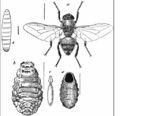Difference between revisions of "Hypoderma spp."
| Line 1: | Line 1: | ||
| + | {{unfinished}} | ||
| + | |||
[[Image:Warble flies.jpg|thumb|right|150px|Warble Fly - Geo. H. Carpenter, Cambridge University Press 1913 - Wikimedia Commons]] | [[Image:Warble flies.jpg|thumb|right|150px|Warble Fly - Geo. H. Carpenter, Cambridge University Press 1913 - Wikimedia Commons]] | ||
Revision as of 12:51, 26 July 2010
| This article is still under construction. |
Scientific Classification
| Kingdom | Animalia |
| Phylum | Arthropoda |
| Class | Insecta |
| Order | Diptera |
| Family | Oestridae |
| Genus | Hypoderma |
There are two important Hypoderma ssp. found in cattle, namely; H. bovis and H. lineatum. H. diana is also a parasite of clinical significance, affecting the deer population.
Hypoderma bovis
| Also known as: | Warble fly
|
Identification
H. bovis are 15mm in length, and have a bumble-bee appearance. The abdomen is yellow, and there is a band of black hairs located down the middle. Large 13-15mm long.
Life Cycle
H. bovis lays single eggs on hairs around the lower legs of the host. The larvae develop and enter the body through the skin, where they migrate to the epidural fat found along the thoracic and lumbar vertebrae of the spine. The larvae stay here for the duration of the winter.
The larvae are palpable as distinct swellings, known as warbles.
Hypoderma lineatum
| Also known as: | Warble fly
|
Identification
H. lineatum are 13mm in length, and like H. bovis have a bee-like appearance.
Life Cycle
The eggs are laid in rows of around 6 on single hairs. The eggs then penetrate the skin and move along the connective tissue toward the diaphragm. They will continue to migrate, until they reach the oesophagus where the larvae will spend the duration of the winter. After 3 months larvae reach winter resting sites where they remain from November to February/March whilst moulting to the L2 stage.
Adult flies emerge on warm, sunny days between June and August. The adult lives for around 3 weeks.
Hypoderma diana
| Also known as: | Warble fly |
Identification
The adult H. diana is around 15mm in length and like both H. bovis and H. lineatum.
Life Cycle
The adults have a short life-span, and do not feed. Eggs are laid on the legs and lower body of the host. Larvae crawl down the hairs, and begin migration through the skin. The larvae burrow along the spinal cord, and send the winter in the epidural fat of the spine around the thoracic and lumbar region.
The migration is then initiated in the spring and warbles then begin to form along the back of the host.
